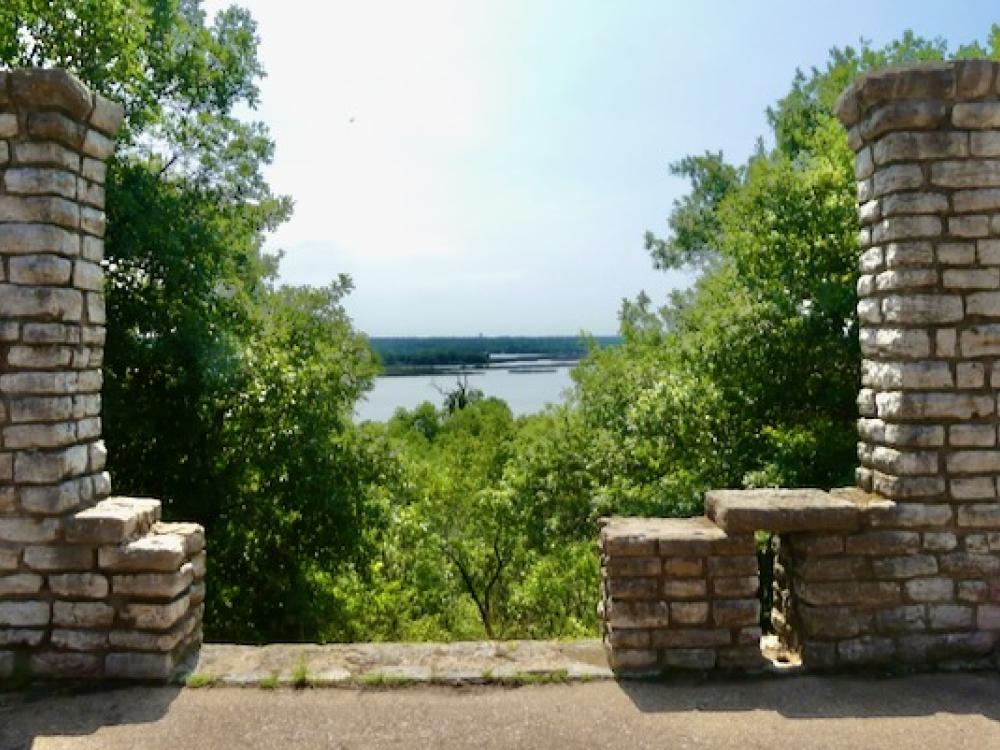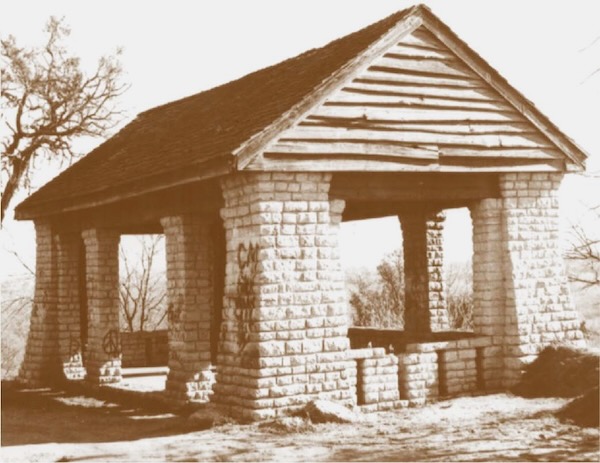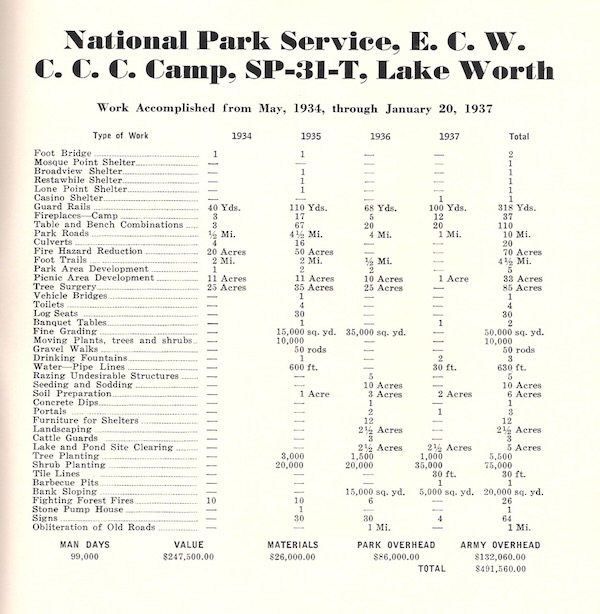
The view overlooking Lake Worth from the Broadview Shelter, built by the Civilian Conservation Corps at the Fort Worth Nature Center and Refuge in the 1930s. Photo by Michael Smith.
June 16, 2023
Looking around at the historic structures and overlooks at the Fort Worth Nature Center and Refuge you might not be surprised to learn it was once planned to be a state park.
Work performed nearly 90 years ago by the Civilian Conservation Corps at the now 3,600-acre city-owned park still dots the landscape.
You can see their handywork in the pavilions and picnic tables and remnants of other stonework that once provided bathrooms and water fountains. Other traces include slabs of limestone arranged as stairs leading from ridge tops down to the lake shore and culverts under the roads.
Recently, the contributions of the boys and young men who worked in the Civilian Conservation Corps were recognized at the Nature Center.
On June 3, representatives of a CCC Legacy organization, the city of Fort Worth and the Nature Center dedicated a statue of one of the “CCC boys.”
 The Broadview Shelter built by the CCC with its wooden roof intact in this undated photo. Courtesy of the Fort Worth Nature Center and Refuge.
The Broadview Shelter built by the CCC with its wooden roof intact in this undated photo. Courtesy of the Fort Worth Nature Center and Refuge.
If you walk from the Refuge Service Center parking area toward the old Broadview Park area, you will be greeted by a life-sized statue of a young man with an axe. The statue was made possible by the family of Steve Porter, whose uncle was a CCC worker.
PUTTING AMERICANS TO WORK
According to Mike Pixler, president of CCC Legacy Chapter 123, the CCC was in existence from 1933 to 1942 when funding ended. The program was a response to the Great Depression and devastating drought in the “Dust Bowl” of the central U.S.
When President Franklin Roosevelt was inaugurated, he instituted a series of programs under the New Deal to help Americans get through the economic and environmental catastrophes. According to the CCC Legacy website, one of these New Deal programs was the Emergency Conservation Work Act, more commonly known as the Civilian Conservation Corps.
According to the National Park Service, these young men were ages 18 to 25, and this was later expanded to 17 to 28.

200 Civilian Conservation Corps men detraining at Texas and Pacific Railway station in Fort Worth before boarding trucks for Lake Worth in 1934. Courtesy, Fort Worth Star-Telegram Collection, Special Collections, The University of Texas at Arlington Libraries.
Each of these young men was provided housing, food, clothing, medical care and lived in camps near the areas where they worked. All this was sorely needed — the average weight gain per man after two months of service was 12 pounds. An article written at the time details how different branches of government worked together to provide this.
CCC IN NORTH TEXAS
I walked with Pixler across an oak savannah filled with wildflowers. We reached the Broadview Shelter, whose wooden roof burned years ago, leaving the concrete floor and cut stone pillars. It overlooks Lake Worth.
Pixler talked with me about how the CCC worked.
 Bunk beds in one of the barracks at the Civilian Conservation Corps Camp near Azle at Eagle Mountain Lake in 1940. Courtesy, Fort Worth Star-Telegram Collection, Special Collections, The University of Texas at Arlington Libraries.
Bunk beds in one of the barracks at the Civilian Conservation Corps Camp near Azle at Eagle Mountain Lake in 1940. Courtesy, Fort Worth Star-Telegram Collection, Special Collections, The University of Texas at Arlington Libraries.
“The Army was responsible for housing and transportation … the Forest Service and Corps of Engineers helped establish what projects we wanted to do. The main thing was to get these boys work and hopefully out of the Depression,” Pixler said. “The stones came from the area, some from Maypearl, but would have been cut with hammer and chisel on location at the Nature Center. All around Lake Worth – Moss Point, Inspiration Point – all that was accomplished by the CCC and specifically Company 1816.”
This was all done in the expectation that a state park — SP 31T — would be established here. That never happened, but in later years the Nature Center benefited from roads, a few of the trails and all the structures built by the CCC.
 A remnant of a CCC picnic table at Fort Worth Nature Center serves as a reminder of the Center's beginnings. Photo by Michael Smith.
A remnant of a CCC picnic table at Fort Worth Nature Center serves as a reminder of the Center's beginnings. Photo by Michael Smith.
The CCC did build other state parks, including nearby Cleburne and Possum Kingdom State Parks. The beautiful Indian Lodge within Davis Mountains State Park was built by CCC as well. In fact, a total of 29 state parks came from the efforts of the CCC.
In Dallas, the work of the CCC lives on at dozens of sites, including the Bachman Lake Park, Flag Pole Hill and parts of White Rock Lake Park.
Jim Rau, a member of the Board of Directors of the CCC Legacy Group, added more information.
“In 1934, Roosevelt’s ‘Tree Army’ arrived here at the place now known as the Fort Worth Nature Center. They would work 99,000 worker hours on this project and other projects around the lake.”
He said that CCC project 1816 consisted of about 200 young men.
“When you walk through the trails deep into the woods, listen for echoes of the past,” Rau said. “You might hear CCC boys working, laughing, learning, providing for their families and also serving their country. They made $30 a month but they had to send $25 of it home to Mama.”
 A statue of a CCC worker was dedicated at the Fort Worth Nature Center recently. Photo by Michael Smith.
A statue of a CCC worker was dedicated at the Fort Worth Nature Center recently. Photo by Michael Smith.
Fort Worth Nature Center Manager Rob Denkhaus saw another contribution, one that he “cannot prove” but nevertheless infers about how the CCC experience shaped the lives of the men who participated.
Denkhaus sees a growing respect for the natural world in visitors to the Nature Center. He attributes the cultural evolution in part to the environmental ethic the CCC boys gained while working in areas “just like this.”
“I think their biggest contribution is in changing the way we as a people view the outdoors.”
The structures at the Nature Center have stood up to the passage of time pretty well. Though some picnic tables or benches are toppled and the wooden roofs of shelters like the one at Broadview are gone. However, on the walk he led after the statue’s dedication, Denkhaus said that the Nature Center hopes to carefully restore the CCC structures in the future.
Below a CCC artifact outlining the work completed between 1934-1937 at SP-31, the planned for state park that became the Fort Worth Nature Center. Courtesy of FWNCR.

RELATED ARTICLES
Fort Worth forest remnant receives national recognition
New viewing deck overlooks bison herd in Fort Worth
Fort Worth Nature Center expanding boardwalk
New land acquired by Fort Worth Nature Center will serve as buffer
Fort Worth Nature Center offers window into region’s wild past
Stay up to date on everything green in North Texas, including the latest news and events! Sign up for the weekly Green Source DFW Newsletter! Follow us on Facebook,Twitter and Instagram. Also check out our podcast The Texas Green Report, available on your favorite podcast app.









